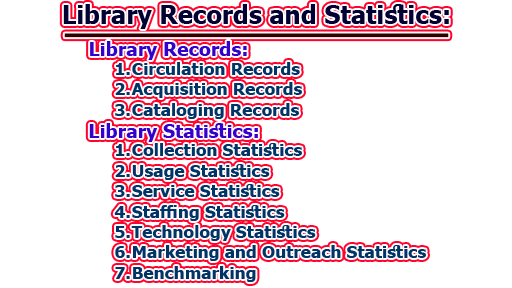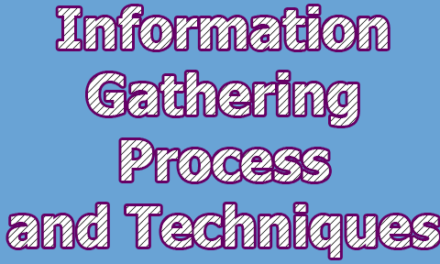Library Records and Statistics:
Libraries play an essential role in society by providing access to information, education, and entertainment. In this digital age, where information is widely available on the internet, libraries remain relevant and necessary because they offer access to resources that are not freely available online. Libraries collect, organize, and make available a wide range of materials, including books, periodicals, newspapers, audio and video recordings, and electronic resources. They also provide services such as reference and research assistance, literacy programs, and community events. In this article, we will explore library records and statistics, which are vital tools for assessing the effectiveness of library services and operations.
Library Records:
Library records are documents that record library transactions, including the circulation of materials, acquisitions, and cataloging. These records are critical for managing the library’s collection and operations, as they provide a way to track the usage and movement of materials, identify collection gaps, and plan for future purchases. Library records also serve as a historical record of the library’s activities and can provide valuable information for research and analysis.
- Circulation Records: Circulation records track the borrowing and returning of library materials. These records contain information such as the item’s title, author, and call number, as well as the borrower’s name and the date of checkout and return. Circulation records are critical for managing the library’s collection, as they provide information on which items are popular and which are not being used. This information can be used to make decisions about weeding the collection, purchasing new materials, or relocating items to a more accessible location.
- Acquisition Records: Acquisition records track the purchase or donation of library materials. These records contain information such as the item’s title, author, publisher, and cost. Acquisition records are critical for managing the library’s budget, as they provide information on how much money is being spent on materials and what types of materials are being purchased. Acquisition records can also be used to identify potential donors or sources of funding for future purchases.
- Cataloging Records: Cataloging records track the organization and description of library materials. These records contain information such as the item’s title, author, subject headings, and call number. Cataloging records are critical for managing the library’s collection, as they provide a standardized way to locate and retrieve materials. Cataloging records can also be used to identify collection gaps or duplication of materials.
Library Statistics:
Library statistics are numerical data that measure various aspects of library operations and services. These statistics are used to evaluate the effectiveness of library services and operations, identify areas for improvement, and compare the library’s performance to other libraries. Library statistics can be used by library staff, administrators, and stakeholders, such as funders and policymakers.
- Collection Statistics: Collection statistics measure various aspects of the library’s collection, including the size, age, and format of materials. These statistics can be used to identify collection gaps, plan for future purchases, and compare the library’s collection to other libraries. Collection statistics can also be used to assess the diversity and inclusiveness of the collection.
- Usage Statistics: Usage statistics measure how library materials and services are being used by patrons. These statistics include circulation, reference, and program attendance data. Usage statistics can be used to identify popular materials and services, assess the effectiveness of library programs, and identify areas for improvement. Usage statistics can also be used to justify funding requests and demonstrate the library’s value to stakeholders.
- Service Statistics: Service statistics measure the various services offered by the library, such as reference assistance, interlibrary loan, and outreach programs. These statistics can be used to assess the effectiveness of library services, identify areas for improvement, and compare the library’s performance to other libraries. Service statistics can also be used to demonstrate the library’s impact on the community.
- Staffing Statistics: Staffing statistics measure the number and qualifications of library staff. These statistics can be used to assess the library’s staffing needs, identify areas for professional development, and compare the library’s staffing levels and qualifications to other libraries. Staffing statistics can also be used to justify funding requests and demonstrate the importance of investing in library staff.
- Technology Statistics: Technology statistics measure the library’s use of technology, including the number of computers, electronic resources, and website visits. These statistics can be used to assess the library’s technological infrastructure, identify areas for improvement, and compare the library’s technology use to other libraries. Technology statistics can also be used to justify funding requests and demonstrate the library’s ability to adapt to changing technological needs.
- Marketing and Outreach Statistics: Marketing and outreach statistics measure the library’s efforts to reach and engage with the community, including the number of program attendees, social media followers, and outreach events. These statistics can be used to assess the effectiveness of the library’s marketing and outreach strategies, identify areas for improvement, and compare the library’s outreach efforts to other libraries. Marketing and outreach statistics can also be used to demonstrate the library’s impact on the community and justify funding requests for outreach programs.
- Benchmarking: Benchmarking is the process of comparing the library’s statistics to those of other libraries. Benchmarking can be used to identify best practices, set goals, and measure the library’s performance against industry standards. Benchmarking can be done at the local, regional, national, or international level, depending on the library’s needs and resources.
- Local Benchmarking: Local benchmarking involves comparing the library’s statistics to those of other libraries in the same region or community. Local benchmarking can help libraries identify areas for improvement and set goals that are relevant to their local context. Local benchmarking can also foster collaboration between libraries and encourage the sharing of best practices.
- Regional Benchmarking: Regional benchmarking involves comparing the library’s statistics to those of other libraries in the same geographic region. Regional benchmarking can help libraries identify regional trends and best practices and set goals that are relevant to their regional context. Regional benchmarking can also provide opportunities for regional collaboration and the sharing of resources.
- National Benchmarking: National benchmarking involves comparing the library’s statistics to those of other libraries in the same country. National benchmarking can help libraries identify national trends and best practices and set goals that are relevant to their national context. National benchmarking can also provide opportunities for national collaboration and the sharing of resources.
- International Benchmarking: International benchmarking involves comparing the library’s statistics to those of libraries in other countries. International benchmarking can help libraries identify global trends and best practices and set goals that are relevant to their international context. International benchmarking can also provide opportunities for international collaboration and the sharing of resources.
From the above discussion, we can say that library records and statistics are essential tools for managing library collections and operations, assessing the effectiveness of library services, and demonstrating the library’s value to stakeholders. Library staff can use these tools to identify areas for improvement, set goals, and measure the library’s performance against industry standards. Benchmarking can provide opportunities for collaboration and the sharing of best practices at the local, regional, national, and international levels. By utilizing library records and statistics, libraries can continue to provide valuable services and resources to their communities in the digital age.
References:
- American Library Association. (2008). Standards for Libraries in Higher Education.
- Association of College and Research Libraries. (2018). Academic Library Trends and Statistics for Carnegie Classifications: 2017-2018.
- Association of Research Libraries. (2018). ARL Statistics 2016-2017.
- Council on Library and Information Resources. (2014). CLIR Issues Number 95: The State of Digital Preservation in 2014: A Snapshot of Challenges and Gaps.
- International Federation of Library Associations and Institutions. (2015). Guidelines for Library Statistics.
- Library of Congress. (2018). The Library of Congress FY 2019 Congressional Justification.
- National Center for Education Statistics. (2017). Digest of Education Statistics, 2016.
- (2018). OCLC Global Library Statistics.
- Public Library Association. (2018). Public Library Data Service Statistical Report 2017.
- United Nations. (2017). Sustainable Development Goal 4: Quality Education.

Assistant Teacher at Zinzira Pir Mohammad Pilot School and College










